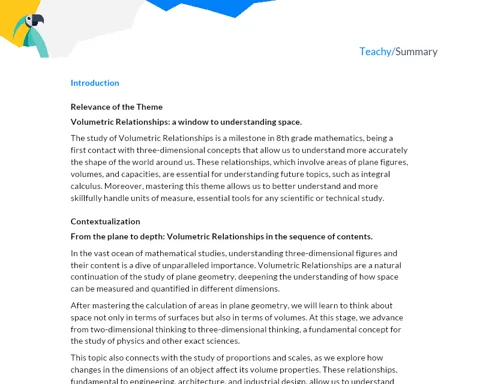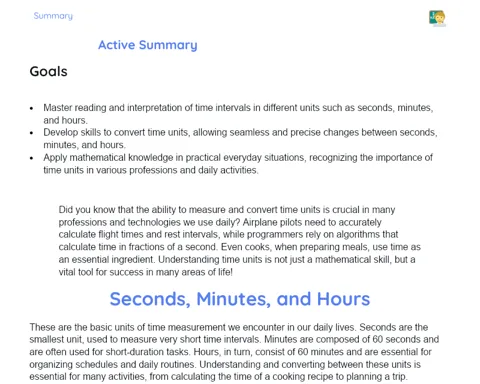Introduction
Relevance of the Topic
The concept of 'Circle Area' is a crucial component of the Mathematics discipline. With its practical and theoretical application, this skill is a vital step towards the conceptual understanding of mathematics and a bridge to more advanced geometry. The fundamental operation of calculating the area of the circle (πr²) provides a concrete insight into abstract concepts, offering a unique opportunity to combine the properties of two-dimensional figures (circles) with a number (π) - a symbol that always fascinates students.
Contextualization
The study of the Circle Area is inserted within the broader unit on Areas and Perimeters, which includes the study of various flat figures and solids. It is a skill that comes after the study of the Areas of Squares and Rectangles, and before the study of irregular figures such as Triangles and Trapezoids. This situates the Circle Area as a key component within the mathematical journey, allowing students to progress from the abstraction of analytical geometry to the applicability of real-world calculus, where (πr²) is often used. Therefore, the study of the Circle Area is an essential transitional moment for students, introducing and refining fundamental mathematical skills.
Theoretical Development
Components
-
Circle Radius (r):
- Defines the size of the circle, being the distance from the center to any point on the circumference.
- It is essential for calculating the area of the circle, as it is used in the square of the radius (r²).
-
Circle Diameter (d):
- Twice the radius (d = 2r).
- It is a line that passes through the center of the circle and touches two points on the circumference.
- The diameter is important because, instead of the radius, it is used in other formulas related to the circle, such as the calculation of the perimeter (2πr).
-
Circle Circumference (C):
- It is the path or outline that surrounds the circle.
- The length of the circumference (C) is calculated using the formula 2πr or πd, where r represents the radius and d the diameter.
-
Circle Area (A):
- Surface space within the precise boundaries of the circle.
- The area of the circle is calculated using the formula πr², where r represents the radius and π is a mathematical constant approximately equal to 3.14.
Key Terms
-
Circle:
- A flat geometric figure that is defined as the set of all points in the same plane at a fixed distance from a point called the center.
- It is a figure with an infinite number of sides, all of which are the same size.
-
Circle Center:
- The point in the circle's plane from which all points on the circumference are equidistant.
- This point is crucial, as from its position the equidistance that defines the circle is established.
-
Circumference:
- It is the boundary (or demarcation line) of the circle, exemplifying that the distance from any point on the circumference to the center is always the same.
Examples and Cases
-
Example 1: Calculating the Area of a Circle
- Consider a circle with a radius of 4 cm. The area formula, πr², can be used to find the area. Therefore, A = π(4²) = 16π cm², or approximately 50.27 cm².
-
Example 2: Connection between Diameter and Area
- Suppose a circle with a diameter of 8 m. To calculate the area, we must first find the radius (r = d/2 = 8/2 = 4), and then apply the area formula, πr². Thus, A = π(4²) = 16π m², or approximately 50.27 m².
-
Example 3: Using Circle Area in Practice
- In the real world, understanding the calculation of the circle area is useful in many situations. For example, a farmer may want to know the amount of land (in square meters or hectares) needed to cultivate a crop in the shape of a circle with a certain radius. Calculating the area of the circle can provide a precise answer for this farmer.
Detailed Summary
Key Points
-
Importance of Radius and Diameter: The radius and diameter are fundamental for the definition and calculation of the circle. The radius (r) is the distance from the center of a circle to any point on its circumference, while the diameter (d) is the distance from a point on a circumference to an opposite point, passing through the center. From the radius or diameter, we can calculate the area of the circle and its perimeter (circumference).
-
Differences and Connections between Radius and Diameter: It is crucial to understand that the diameter is always twice the radius (d = 2r). Additionally, the radius is used to calculate the area of the circle (A = πr²), while the diameter is used to calculate the perimeter of the circle (C = πd or C = 2πr).
-
Circle Area Formula: The area of the circle (A) is calculated by multiplying the square of the radius (r²) by the mathematical constant π (pi). This formula (A = πr²) is crucial for the understanding and calculation of the circle area.
-
Relation between Area and Radius: The area of a circle is directly proportional to the square of its radius. This means that if the radius of a circle increases, its area will increase in the same proportion, and if the radius decreases, its area will decrease in the same proportion.
Conclusions
-
Applicability of Mathematics in Everyday Life: The study of the circle and its area (πr²) demonstrates how mathematics is present in everyday situations. The circle area formula, for example, is used to calculate circular surfaces in a variety of fields, such as architecture, engineering, science, among others.
-
Connection between Different Mathematical Concepts: Understanding the circle area also reinforces the connection between different mathematical concepts, such as geometry (study of figures) and algebra (use of formulas and constants). Through the circle, we can see how these areas of mathematics intertwine and apply to the real world.
Suggested Exercises
-
Exercise 1: Area Calculation
- If a circle has a radius of 5 cm, calculate its area. Answer in terms of 'π'.
-
Exercise 2: Radius Calculation
- If the area of a circle is 144π m², what is its radius?
-
Exercise 3: Application of the Concept
- A circular-shaped snack has a 10 cm diameter. How much butter is needed to cover the entire surface of this snack? (Tip: Use the circle area formula to calculate the area of the snack's surface.)



